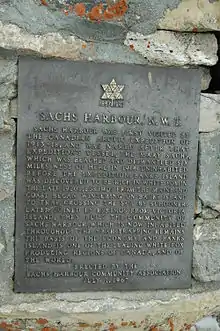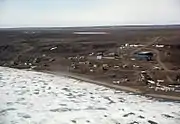Sachs Harbour
Sachs Harbour is a hamlet located in the Inuvik Region of the Northwest Territories, Canada. Situated on the southwestern coast of Banks Island in the Inuvialuit Settlement Region, the population according to the 2016 census count was 103 people. The two principal languages in the town are Inuinnaqtun (Inuvialuktun) and English.[1] The traditional name for the area is Ikahuak, meaning "where you go across to". Bulk supplies of food and other items are brought by barge in the summer months and flights from Inuvik, some 325 mi (523 km) to the southwest, operate all year, via the Sachs Harbour (David Nasogaluak Jr. Saaryuaq) Airport. Sachs Harbour is the only permanent settlement on Banks Island.
Sachs Harbour
Ikahuak | |
|---|---|
 | |
 Sachs Harbour  Sachs Harbour | |
| Coordinates: 71°59′12″N 125°15′02″W | |
| Country | Canada |
| Territory | Northwest Territories |
| Region | Inuvik Region |
| Constituency | Nunakput |
| Census division | Region 1 |
| First permanent settlement | 1929 |
| Incorporated (hamlet) | 1 April 1986 |
| Government | |
| • Mayor | Norman Anikina (acting) |
| • Senior Administrative Officer | Steve Wylie |
| • MLA | Herbert Nakimayak |
| Area | |
| • Land | 290.94 km2 (112.33 sq mi) |
| Elevation | 86 m (282 ft) |
| Population (2016)[1] | |
| • Total | 103 |
| • Density | 0.4/km2 (1/sq mi) |
| Time zone | UTC−07:00 (MST) |
| • Summer (DST) | UTC−06:00 (MDT) |
| Canadian Postal code | X0E 0Z0 |
| Area code(s) | 867 |
| Telephone exchange | 690 |
| - Living cost | 177.5A |
| - Food price index | 174.6B |
| Sources: Department of Municipal and Community Affairs,[2] Prince of Wales Northern Heritage Centre,[3] Canada Flight Supplement[4] ^A 2013 figure based on Edmonton = 100[5] ^B 2015 figure based on Yellowknife = 100[5] | |
The town was named after the ship Mary Sachs, which was part of the Canadian Arctic Expedition of 1913.
Community life

The community's economy is based largely on hunting and trapping, but tourism also plays a small role. Most of the town lies within 250 yd (230 m) of the shoreline. Residents engage in ice fishing, harvesting fish from the Amundsen Gulf and the Beaufort Sea. There is a goose hunt every spring - Banks Island being the home to the largest goose colony in North America. The community is also home to the largest commercial muskox harvests in Canada. Three quarters of the world's population of muskoxen roam the island. Barren-ground caribou and polar bear are also seen on the island. On April 26, 2006, the world's first documented wild-born grizzly–polar bear hybrid was shot near the town.
Aulavik National Park
Sachs Harbour is the headquarters of Aulavik National Park and the Visitor Reception Centre is situated in Sachs Harbour. Aulavik National Park is located on the north end of Banks Island, and is co-operatively managed by Parks Canada with the residents of Sachs Harbour and the broader Inuvialuit community. The Visitor Reception Centre presents the park and Inuvialuit culture to visitors to Banks Island, as well as serves as a centre for community activities. On the north shore of Banks Island within Aulavik National Park is a narrow bay, Mercy Bay, penetrating some distance into the park. It is of historical significance for one of a number of ships sent out to the Arctic by the Admiralty to find the lost expedition of John Franklin, became trapped in the ice in the bay for some three years and had to be abandoned by its crew. That ship was the Investigator and its captain, Commander Robert McClure. The Investigator sailed from England all around North and South America so that it passed through the Bering Strait in an attempt to find the Northwest Passage from the west while looking for Franklin's lost expedition.
Exploration
Oil and gas exploration has provided jobs over the years for some Sachs Harbour residents—estimates of commercially recoverable oil in the Beaufort Sea range from 4 to 12 billion barrels (640,000,000 to 1.91×109 m3), and there is believed to be between 13 and 63 trillion cubic feet (370 and 1,780 km3) of natural gas.
Services
Services include a two-member Royal Canadian Mounted Police detachment and a health centre with one nurse.[6] Phone services are provided by Northwestel with Internet access. The local hunters and trappers association provides outfitting for big-game hunts like muskox and polar bears.
Demographics
|
| ||||||||||||||||||||||||||||||||||||||||||||||||||||||||||||||||||||||||
| Sources: NWT Bureau of Statistics (2001 - 2017)[7] | |||||||||||||||||||||||||||||||||||||||||||||||||||||||||||||||||||||||||
In 2017 the Government of the Northwest Territories reported that the population was 112 with an average yearly growth rate of -0.9 from 2007.[5]
Gallery
 Located on the southern shores of Banks Island
Located on the southern shores of Banks Island This site was closed and abandoned years ago
This site was closed and abandoned years ago Sachs Harbour's population has been declining and now has approximately 90 residents
Sachs Harbour's population has been declining and now has approximately 90 residents
Climate
Sachs Harbour is in the Arctic tundra climatic zone (ET), characterized by long, cold winters. Since the activities of many residents of the community revolve around fishing, hunting, and travel, many residents have considerable knowledge of weather conditions, permafrost, and even erosion patterns. Because of climate changes in recent years, local residents fear their knowledge of weather patterns may not be of much use, as the weather has become harder to predict. Since the climate has been changing, sea ice has been breaking up earlier than normal, taking seals farther south in the summer. Seals are one of the main sources of food for the town. Sockeye and pink salmon appeared for the first time in nearby waters between 1999 and 2001.[8] New species of birds are migrating to the island, including robins and barn swallows, and more flies and mosquitos have been appearing.[9][10]
| Climate data for Sachs Harbour (David Nasogaluak Jr. Saaryuaq) Airport | |||||||||||||
|---|---|---|---|---|---|---|---|---|---|---|---|---|---|
| Month | Jan | Feb | Mar | Apr | May | Jun | Jul | Aug | Sep | Oct | Nov | Dec | Year |
| Record high humidex | −4.4 | −6.1 | −5.6 | 3.0 | 9.4 | 23.5 | 26.0 | 23.7 | 16.3 | 3.9 | 1.1 | −4.3 | 26.0 |
| Record high °C (°F) | −4.4 (24.1) |
−4.5 (23.9) |
−4.0 (24.8) |
2.2 (36.0) |
10.0 (50.0) |
20.5 (68.9) |
24.2 (75.6) |
21.5 (70.7) |
15.6 (60.1) |
4.4 (39.9) |
1.7 (35.1) |
−4.0 (24.8) |
24.2 (75.6) |
| Average high °C (°F) | −24.4 (−11.9) |
−24.5 (−12.1) |
−23.1 (−9.6) |
−14.6 (5.7) |
−4.6 (23.7) |
6.1 (43.0) |
10.0 (50.0) |
6.5 (43.7) |
1.2 (34.2) |
−7.7 (18.1) |
−17.1 (1.2) |
−21.5 (−6.7) |
−9.5 (14.9) |
| Daily mean °C (°F) | −28.0 (−18.4) |
−28.3 (−18.9) |
−26.7 (−16.1) |
−18.3 (−0.9) |
−7.6 (18.3) |
3.1 (37.6) |
6.6 (43.9) |
3.7 (38.7) |
−1.2 (29.8) |
−10.7 (12.7) |
−20.5 (−4.9) |
−25.1 (−13.2) |
−12.8 (9.0) |
| Average low °C (°F) | −31.7 (−25.1) |
−32.1 (−25.8) |
−30.3 (−22.5) |
−22.0 (−7.6) |
−10.5 (13.1) |
0.1 (32.2) |
3.1 (37.6) |
0.9 (33.6) |
−3.4 (25.9) |
−13.7 (7.3) |
−23.9 (−11.0) |
−28.5 (−19.3) |
−16.0 (3.2) |
| Record low °C (°F) | −52.2 (−62.0) |
−50.2 (−58.4) |
−48.4 (−55.1) |
−43.0 (−45.4) |
−26.7 (−16.1) |
−16.5 (2.3) |
−5.0 (23.0) |
−11.0 (12.2) |
−22.8 (−9.0) |
−35.5 (−31.9) |
−42.8 (−45.0) |
−45.0 (−49.0) |
−52.2 (−62.0) |
| Record low wind chill | −71.6 | −68.1 | −64.8 | −58.4 | −40.3 | −21.1 | −10.3 | −20.4 | −31.2 | −44.9 | −56.4 | −64.1 | −71.6 |
| Average precipitation mm (inches) | 4.9 (0.19) |
6.6 (0.26) |
7.1 (0.28) |
12.1 (0.48) |
9.1 (0.36) |
7.5 (0.30) |
17.6 (0.69) |
28.9 (1.14) |
22.0 (0.87) |
20.0 (0.79) |
9.0 (0.35) |
7.0 (0.28) |
151.5 (5.96) |
| Average rainfall mm (inches) | 0.0 (0.0) |
0.0 (0.0) |
0.0 (0.0) |
0.0 (0.0) |
0.1 (0.00) |
5.1 (0.20) |
16.7 (0.66) |
24.7 (0.97) |
11.2 (0.44) |
0.5 (0.02) |
0.0 (0.0) |
0.0 (0.0) |
58.3 (2.30) |
| Average snowfall cm (inches) | 5.2 (2.0) |
7.0 (2.8) |
7.7 (3.0) |
12.4 (4.9) |
9.3 (3.7) |
2.4 (0.9) |
0.9 (0.4) |
4.1 (1.6) |
10.9 (4.3) |
20.2 (8.0) |
9.4 (3.7) |
8.3 (3.3) |
97.7 (38.5) |
| Average precipitation days (≥ 0.2 mm) | 6.5 | 6.3 | 6.7 | 5.6 | 7.4 | 4.7 | 8.1 | 14.5 | 12.0 | 13.7 | 8.2 | 6.2 | 99.9 |
| Average rainy days (≥ 0.2 mm) | 0.0 | 0.0 | 0.0 | 0.0 | 0.2 | 2.9 | 7.8 | 11.7 | 5.4 | 0.6 | 0.0 | 0.0 | 28.7 |
| Average snowy days (≥ 0.2 cm) | 6.6 | 6.4 | 6.7 | 5.6 | 7.3 | 1.8 | 0.6 | 3.4 | 7.4 | 13.3 | 8.3 | 6.3 | 73.5 |
| Average relative humidity (%) | 84.3 | 81.6 | 76.9 | 81.7 | 88.9 | 86.7 | 87.8 | 93.9 | 91.9 | 88.2 | 86.0 | 86.3 | 86.4 |
| Mean monthly sunshine hours | 0.0 | 27.5 | 168.6 | 276.0 | 252.0 | 397.3 | 254.2 | 152.8 | 76.9 | 36.6 | 0.0 | 0.0 | 1,641.9 |
| Percent possible sunshine | 0.0 | 15.6 | 47.1 | 54.9 | 34.9 | 55.2 | 34.2 | 25.0 | 18.8 | 13.7 | 0.0 | 0.0 | 33.3 |
| Source: Environment Canada Canadian Climate Normals 1981–2010[11] | |||||||||||||
References
- "Census Profile, 2016 Census Sachs Harbour, Hamlet [Census subdivision], Northwest Territories and Northwest Territories [Territory]". 2016 Census. Statistics Canada.
- "NWT Communities - Sachs Harbour". Government of the Northwest Territories: Department of Municipal and Community Affairs. Retrieved 2014-01-16.
- "Northwest Territories Official Community Names and Pronunciation Guide". Prince of Wales Northern Heritage Centre. Yellowknife: Education, Culture and Employment, Government of the Northwest Territories. Archived from the original on 2016-01-13. Retrieved 2016-01-13.
- Canada Flight Supplement. Effective 0901Z 16 July 2020 to 0901Z 10 September 2020.
- Sachs Harbour - Statistical Profile at the GNWT
- Infrastructure
- Population Estimates By Community from the GNWT
- First Records of Sockeye (Oncorhynchus nerka) and Pink Salmon (O. gorbuscha) from Banks Island and Other Records of Pacific Salmon in Northwest Territories, Canada
- Observed Climate Change Impacts in Sachs Harbour, Canada
- Climate change impacts on Canadian Western Arctic: the Inuvialuit of Sachs Harbour
- "Sachs Harbour A". Canadian Climate Normals 1981–2010. Environment Canada. Climate ID: 2503650. Retrieved October 19, 2020.
External links
| Wikimedia Commons has media related to Sachs Harbour. |
- The White Fox Fur Trade NWT Historical Timeline, Prince of Wales Northern Heritage Centre